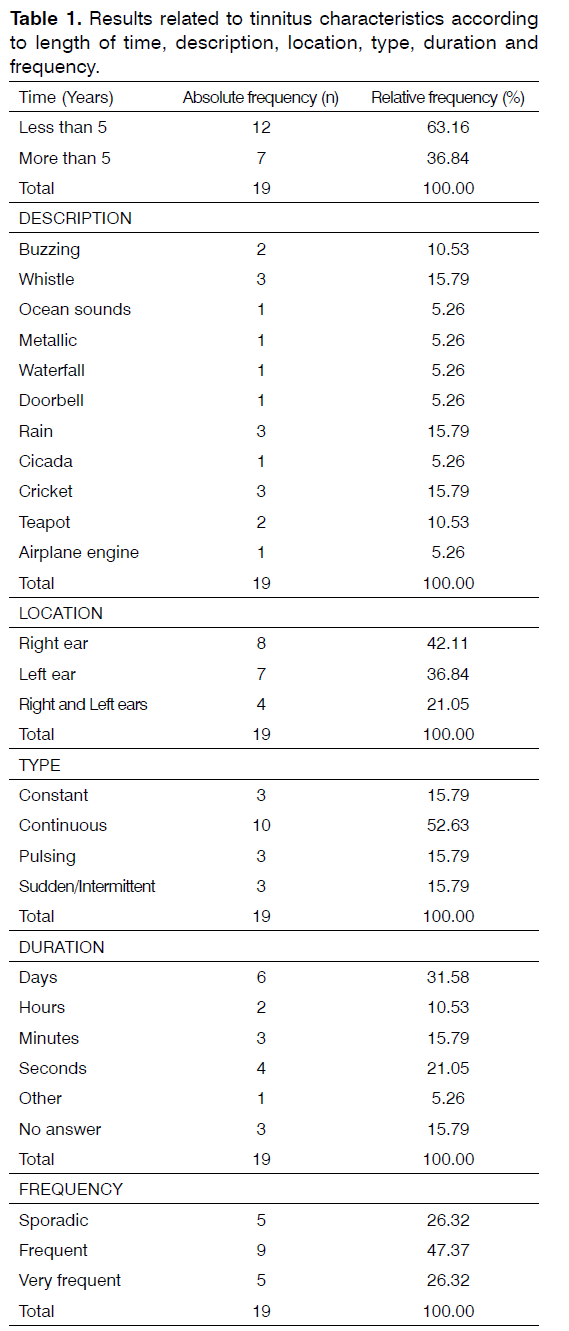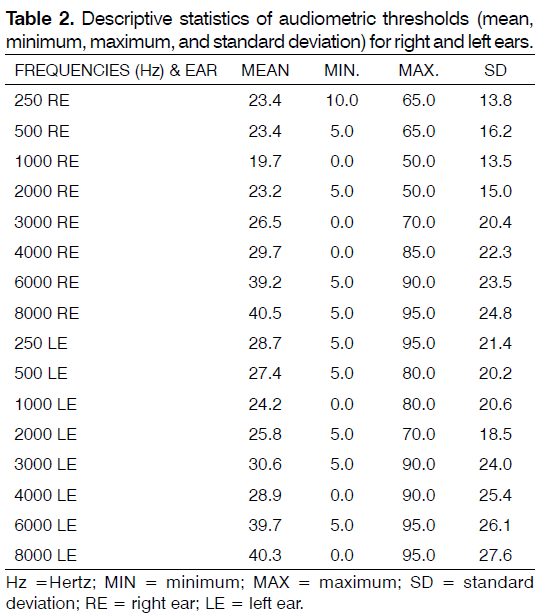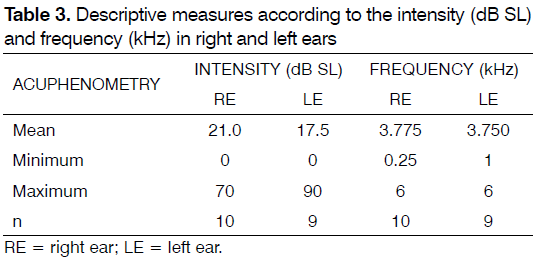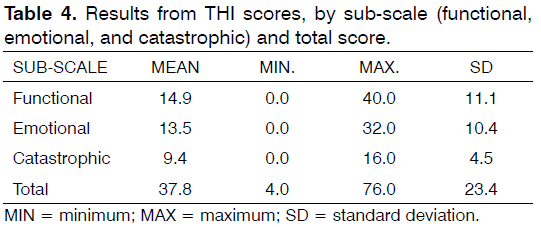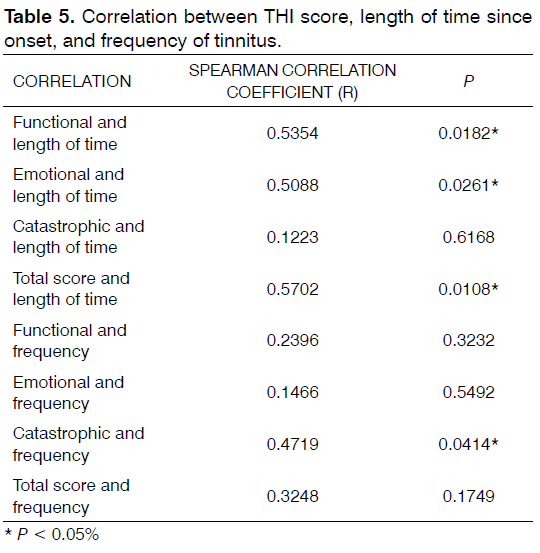The International Tinnitus Journal
Official Journal of the Neurootological and Equilibriometric Society
Official Journal of the Brazil Federal District Otorhinolaryngologist Society
ISSN: 0946-5448

Google scholar citation report
Citations : 12717
The International Tinnitus Journal received 12717 citations as per google scholar report
The International Tinnitus Journal peer review process verified at publons
Indexed In
- Excerpta Medica
- Scimago
- SCOPUS
- Publons
- EMBASE
- Google Scholar
- Euro Pub
- CAS Source Index (CASSI)
- Index Medicus
- Medline
- PubMed
- UGC
- EBSCO
Volume 20, Issue 1 / June 2016
Research Article Pages:24-30
10.5935/0946-5448.20160005
The impact of tinnitus on the quality of life in patients with temporomandibular dysfunction
Authors: Adriana Bender Moreira de Lacerda, Caroline Facco, Bianca Simone Zeigelboim, Killian Cristoff, Jos? Stechman Neto, Vin?cius Ribas Fonseca
PDF
Abstract
Introduction: The most common otological symptoms in patients with temporomandibular disorders (TMD) are ear fullness, tinnitus and ear pain. Objective: To evaluate the impact of tinnitus on the quality of life for patients with TMD.
Method: This is a quantitative, cross-sectional retrospective study. The sample consisted of 19 individuals with TMD, 17 (89.47%) females and 2 (10.53%) male, mean age 53.5 years. Data collection consisted of: anamnesis, pure tone audiometry, acuphenometry and application of the Portuguese version of the Tinnitus Handicap Inventory (Brazilian THI).
Results: 63.12% had had tinnitus for less than five years, and 15.79% had tinnitus that sounded like whistling, rain and/or a cricket. There was a predominance of laterality in the right ear (42.11%). 52.63% of the subjects reported that their tinnitus is continuous, while 31.58% stated that it lasts for days, and 47.37% report that it is common. The audiometry revealed mean audiometric thresholds above 25 dB HL in the high frequencies (3000, 4000, 6000 and 8000 Hz) bilaterally. In acuphenometry, the average loudness of the tinnitus was 21 dB SL the right ear and 17.85 dB SL in the left ear, and the average tinnitus pitch was 3775 Hz in the right ear and 3750 Hz in the left ear. The total THI score was 37.8 points. It appears that there is significant correlation between the THI scale, time of tinnitus duration and its occurrence.
Conclusion: Tinnitus reported in patients with TMD caused moderate impact on quality of life and can be seen in the presence of background noise although daily activities can still be performed
Keywords: temporomandibular joint dysfunction syndrome, tinnitus, pain clinics
Introduction
Tinnitus is the third worst problem that can affect human beings, which corresponds to 20% of cases, second only to pain and severe intractable dizziness [1,2] . Questionnaires used to assess the impact of tinnitus show that it can represent a big nuisance for those who suffer from it and affect their quality of life [2-4] .
In the neurophysiological model [5] , tinnitus results from abnormal processing of sound generated in the auditory system. This erroneous processing occurs before the sound is perceived centrally. Tinnitus is the result of continuous firing of cochlear fibers to the brain due to hyperactivity of the hair cells, or permanent damage to these cells, which creates a phantom sound transmitted to the brain that is heard as a real sound.
Tinnitus is a subjective symptom and is characterized by the presence of one or more sounds perceived in the ears or head in the absence of corresponding external sound stimulus. It affects approximately 17% of the general population and 33% of the elderly population, being severe in 20% of cases. Tinnitus may affect, directly or indirectly, personal, professional and leisure activities, interfere in family and social relationships, and in extreme cases, even lead to suicide [6-8] .
The most important psychoacoustic characteristics of tinnitus are frequency (pitch) and intensity (loudness). Frequency is measured with respect to a range of frequencies (low, medium or high), while intensity corresponds to the volume of the tinnitus sound. Frequency and intensity for tinnitus can be studied by acuphenometry [6,9] .
Tinnitus is a symptom that can accompany various diseases or disorders of the external, middle, or inner ear, brain stem, and cerebral cortex. More than one cause of tinnitus may be present in the same patient10. Diseases that are primarily otological, or diseases that secondarily affect the ear and have tinnitus as a symptom, are metabolic, cardiovascular, neurological, pharmacological, psychiatric and dental [6-10] .
Among the dental diseases, temporomandibular joint dysfunction (TMD) is a collective term covering a wide range of clinical joint and muscle problems in the orofacial area. These disorders are mainly characterized by pain in the joint, sounds, and irregular or unlimited mandibular function. [11] TMD can also generate secondary auditory symptoms such as earache, tinnitus, vertigo, dizziness, hearing loss, referred pain or headaches [12-28] . Of the general population, 40-75% show signs of TMD, and 33% have at least one symptom. In addition, 10% have hearing loss and 7-15% complain of tinnitus [29] .
Nerve compression is one of the causes of TMD; the chorda tympani is a branch of the seventh cranial nerve (facial nerve) and the auricular nerve, a sensitive branch of the mandibular nerve, which in turn is a branch of the fifth cranial nerve (trigeminal nerve). Compression of these nerves can cause serious consequences [30] .
Compressions in the bilaminar zone can lead to auditory symptoms commonly observed in patients with TMD (muscle and/or joint origin) and may be related to pressure on the auricular region. The main causes of auricular nerve and chorda tympani compression are poor dental occlusion and craniocervical posture alterations. [30] However, there is no evidence that shows involvement only between TMD and otological symptoms [28] . A predisposition of the association between TMD and otological symptoms in females has been observed [7,9,15,30] . Many reports of relief from or improvement in otological symptoms occur after treatment for TMD [7,11] .
Studies of TMD patients show some psychological involvement with symptoms often interfering with daily activities [31] . The same can be said for tinnitus [3,4,6,7] . Tinnitus and TMD are considered to be somatic syndromes and both are influenced by psychological disorders, depression, and anxiety [32] .
Thus, this study aims to assess the impact of tinnitus on quality of life for patients with TMD through the application of the Brazilian Portuguese version of the Tinnitus Handicap Inventory (Brazilian THI), with a view to promoting health in this population.
Methods
This is a cross-sectional, quantitative study conducted with TMD patients, and approved by opinion number 1.180.334 of the Research Ethics Committee from a public hospital in the city of Curitiba.
The sample consisted of 19 patients in a Brazilian university, evaluated by the Research Diagnostic Criteria/ Temporomandibular Disorders (RDC/TMD). The 19 cases of tinnitus symptoms were referred to the Speech Therapy Clinic of the same university where anamnesis, pure tone audiometry, acuphenometry were performed and the Brazilian THI questionnaire was given [4] .
The anamnesis focused on tinnitus characteristics. Pure tone audiometry was performed using a MADSEN Itera II audiometer in a soundproof booth.
Acuphenometry evaluated the sensation of tinnitus frequency (pitch), through pure tone or narrowband noise at frequencies from 125 Hz to 8000 Hz, presented initially at 5-10 dB SL (loudness), i.e., above audiometric thresholds, and performed on each ear.
The signal was increased in steps of 5 dB HL until the patient stated that it was equivalent to the tinnitus sound. This procedure was performed on each ear.
The THI is an assessment tool with 25 questions [3] and has been translated and adapted to Brazilian Portuguese [4] . Each response is scored respecting the following values: yes (4 points), sometimes (2 points) and no (0 points). The maximum sum achieved is 100 points, and, depending on the result, can show the degree of severity of tinnitus associated with the individual’s quality of life. For the analysis, the THI authors [4] suggest the following scoring ranges:
• 0-16: Slight-barely audible in quiet environments;
• 18-36: Mild-masked by ambient noise, no audible sounds during routine activities;
• 38-56: Moderate-present, even with ambient noise, but not normally interfering with daily activities;
• 58-76: Severe-almost always present, sleep disturbances, can interfere with daily activities;
• 78-100: Catastrophic-always present, sleep disturbances, difficulty in carrying out any activity.
The questionnaire is grouped into three subscales. The functional sub-scale is comprised of eleven questions (1, 2, 4, 7, 9, 12, 13, 15, 18, 20 and 24) and evaluates the limitations that tinnitus causes in: the mental area (“Because of tinnitus do you have trouble concentrating?”); in the social/occupational area (“Because of tinnitus do you not enjoy social activities such as going out to dinner or to the movies?”); and in the physical area (“Because of tinnitus do you have trouble sleeping at night?”). There are nine questions (3, 6, 10, 14, 16, 17, 21, 22 and 25) for the emotional subscale, including a wide range of emotional responses for tinnitus, such as anger, frustration, irritability and depression. And finally there are five questions for the catastrophic subscale (5, 8, 11, 19 and 23) to survey the most severe reactions resulting from tinnitus, such as despair, loss of control, inability to face problems, inability to escape the tinnitus, and fear of having a serious illness [26,28] .
Statistical analysis of this research was conducted with the use of descriptive methods (tables with absolute and relative frequencies) and inferential methods (Student’s t-test) at the 0.05 significance level. Spearman correlation tests were used to compare the duration of tinnitus with quality of life.
Results
There was a predominance of females in the sample (89.47%). The average age of the sample was 53.5 years (range 26-72 years). One can observe a frequency of 42.11% of the sample for patients age 60 years or older, and also of 31.58% age between 40 and 49 years old.
The results related to tinnitus according to the time since onset of tinnitus, description of sound, location, type, duration and frequency are shown in Table 1. 63.12% of the subjects had had tinnitus for less than five years, and 15.79% described their tinnitus as a whistle, rain, or cricket sound. There was a predominance of laterality in the right ear (42.11%). 52.63% of subjects reported that their tinnitus is continuous, and as to the duration of tinnitus sounds, 31.58% stated that the noise lasts days, and 47.37% report that tinnitus is frequent.
Table 2 shows bilateral hearing thresholds. The audiometry revealed a predominance of audiometric average thresholds above 25 dB HL at high frequencies (3000, 4000, 6000, and 8000 Hz) bilaterally.
Table 3 shows the result of acuphenometry according to the intensity (dB SL) and frequency (kHz) in the right and left ears. In acuphenometry, the average tinnitus intensity (loudness) was 21 dB SL in the right ear and 17.85 dB SL in the left ear. The average of tinnitus pitch was 3775 Hz in the right ear and 3750 Hz in the left ear.
Table 4 shows the results of THI scale scores by size and total. The total score of THI was found to be 37.8 points, which shows a moderate impact on quality of life, where the tinnitus can be noticed in the presence of background noise, although daily activities can still be carried out.
Table 5 shows the correlation between THI scores with the duration and frequency of tinnitus. Using the Spearman correlation coefficient, at a significance level of 0.05, there is a significant correlation between THI scores, duration, and frequency.
Discussion
Regarding the profile of the sample, one can verify the predominance of females, something also reported by different authors [9,25] . In relation to age, it was found that the average age of the subjects in this study was 53.5 years old-consistent with results from a study [3] that indicated that 30% of adult patients with tinnitus have an average age equal to or greater than 50. However, in other studies [9,13] , the average age of participants was less than 50 years old.
As to the length of time since onset of tinnitus shown in Table 1, 63.16% had had tinnitus for less than five years. These findings are in agreement with the studies presented by different authors [2,33] which reported the time since onset of tinnitus as less than five years.
Regarding the description of tinnitus sounds (Table 1), whistle, rain and cricket sounds (15.79%) were the most commonly reported, followed by buzzing and teapot sounds (10.53%), which differs from a study [33] that showed that wheezing (40%) was the most reported tinnitus sound description. The findings of another study [9] showed high-pitched tinnitus was the most reported, with 75%, versus 25% for low-pitched.
With regard to the laterality of tinnitus (Table 1), there was a prevalence of tinnitus in the right ear (42.11%) which differs from a study [33] found that showed a higher prevalence of bilateral tinnitus (46%), probably because study participants were occupationally exposed to noise. Another study [9] showed that bilateral tinnitus was the most frequent in normal hearing patients with TMD. However, in yet another study [34] , there was no significant difference between hearing thresholds for high frequencies in the right and left ears of the individuals in the group with tinnitus when compared to the control group, as well as no significant difference regarding the location of the tinnitus [34] .
The findings relating to the type of tinnitus (Table 1) show that more than half of participants report the tinnitus as being constant, in line with the findings of another study [9] . Episodes that last several days were the most reported (31.58%) and these results are in agreement with the findings of one study [33] which showed that a weeklong duration for tinnitus was the most reported (41%).
The findings related to the frequency of tinnitus symptoms (Table 1) showed that 47.37% of respondents report that their tinnitus is frequent. Regarding the intensity of tinnitus, high intensity (42.10%) was the most reported.
It is known that the pathophysiology of tinnitus remains unknown [35] and its relationship to TMD also is not clear. However, high frequency, moderate, oscillating, and sporadic intensities are usually is associated with TMD [12,36] .
As to the audiometric findings (Table 2), involvement of high frequencies bilaterally from 3 kHz corroborates one study [37] , which found a lowering of thresholds in the airways at frequencies of 6 and 8 kHz. However, other studies [7,37,38] showed audiometric thresholds within normal limits. In this sense, the hearing findings in patients with TMD are unclear and need to be better examined.
Regarding acuphenometry results (Table 3), the findings of this study are similar to the literature, which reports high-pitch tinnitus as being most reported by patients [9,39-41] .
With respect to the questionnaire THI (Table 4), it can be seen that the average was 37.8%, which indicates a moderate impact on quality of life. This finding is in agreement with studies [42,43] reporting a higher incidence of moderate impacts (average THI 45.5 and 39 respectively), using the same evaluation tool. This differs from one study [9] that found the nuisance caused by tinnitus classified as mild. Another study [7] showed no significant statistical difference between the results of THI in TMD patients compared to the control group, and also showed no statistically significant correlation between THI and length of time with tinnitus [7] .
When analyzed by sub-scale alone, the functional subscale average of 14.9%, indicated a mild impact on quality of life, affecting the mental, social and physical areas. The emotional subscale had an average of 13.5%, which is also considered to be a mild impact on quality of life, affecting emotional areas, such as feelings of anger, frustration, irritability, and depression that tinnitus can cause. The catastrophic subscale found an average of 9.4%, considered to indicate a mild impact on quality of life for this population, which means an interference of tinnitus with regard to despair, intolerance to tinnitus, and a loss of control in situations that tinnitus can produce. One author [44] found an association of light and mild degrees of tinnitus in individuals who had hearing loss, and mild to catastrophic levels associated with subjects without hearing loss, which was not observed in this study.
When analyzed by sub-scale alone, the functional subscale average of 14.9%, indicated a mild impact on quality of life, affecting the mental, social and physical areas. The emotional subscale had an average of 13.5%, which is also considered to be a mild impact on quality of life, affecting emotional areas, such as feelings of anger, frustration, irritability, and depression that tinnitus can cause. The catastrophic subscale found an average of 9.4%, considered to indicate a mild impact on quality of life for this population, which means an interference of tinnitus with regard to despair, intolerance to tinnitus, and a loss of control in situations that tinnitus can produce. One author44 found an association of light and mild degrees of tinnitus in individuals who had hearing loss, and mild to catastrophic levels associated with subjects without hearing loss, which was not observed in this study.
There is the existence of a significant correlation between the THI score, length of time since onset, and the frequency of tinnitus. As in all significant cases, R correlations are positive, meaning that the higher the score, the longer the time since onset, the more frequent the episodes of tinnitus, the worse the quality of life for the patient. One author [7] already showed no statistically significant correlation between THI and the length of time since onset.
This study had some limitations when considering the sample size and the lack of comparison of cases with a control group. But it is known that one of the greatest difficulties in conducting research in the area of TMD and orofacial pain is the selection of a homogeneous sample and the standardization of results [7] . Due to the subjective nature of tinnitus and TMD, we opted for a cross-sectional study. However, prospective studies are needed to establish a cause-effect relationship between them and associate the characteristics of patients with tinnitus and TMD as a way of assisting the diagnosis and guiding more specific treatments.
The findings of this study reinforce the need for evaluation and multidisciplinary conduct involving ENT surgeons, dentists, and speech-language therapists in the differential diagnosis and treatment of TMD and otological symptoms.
Conclusion
Tinnitus reported in patients with TMD caused a moderate impact on quality of life and can be seen in the presence of background noise, but daily activities can still be performed. It has been found that there is significant correlation between the THI score, length of time since onset, and frequency of tinnitus.
References
- American Tinnutus Association ATA- Information aboute Tinnitus,Portland. 2015 [cited 2015 Dez 8]. Available from: http://www.ata.org
- Sanchez TG, Bento RF, Minti A, Câmara J. Zumbido: característicaseepidemiologia: experiência do Hospital das Clinicas daFaculdade de Medicina da Universidade de São Paulo. Rev BrasOtorrinolaringol. 1997;63(3):229-35.
- Newall P, Mitchell P, Sindhusake D, Golding M, Wigney D, HartleyD, et al. Tinnitus in older people: It is widespread problem.Hear J. 2001;54(11):14-8. DOI: http://dx.doi.org/10.1097/01.HJ.0000293149.86219.30
- Ferreira PGA, Cunha F, Onishi ET, Branco-Barreiro FCA, GanançaFF. Tinnitus handicap inventory: adaptação cultural para oportuguêsbrasileiro. Pró-Fono. 2005;17(3):303-10. DOI: http://dx.doi.org/10.1590/S0104-56872005000300004
- Jastreboff PJ. Clinical Implication of the neurophisiological modelof tinnitus.Procedings of the 5th International Tinnitus Seminar;1996; Portland, Oregon, USA.
- Sameli AG. Zumbido: avaliação, diagnóstico e reabilitação:abordagensatuais. São Paulo: Lovise; 2004.
- Hilgenberg PB. Estudo da participação de sinaissintomas deDisfunçãoTemporomandibular (DTM) e sintomasotológicosempacientesportadores de zumbidosubjetivo. [Dissertação deMestrado]. Escola de Odontologia de Bauru, ÁreaCiências daSaúde: Universidade de São Paulo; 2009.
- Steinmetz LG, Zeigelboim BS, Lacerda AB, Morata TC, Marques JM.Evaluating tinnutus in industrial hearing loss prevention programs.Int Tinnitus J. 2008;14(2):152-8.
- Morais AA, Gil D. Tinnitus in individuals without hearing lossand its relationship with emporomandibular dysfunction. Braz JOtorhinolaryngol. 2012;78(2):59-65. PMID: 22499371
- Saches TG. Quemdisseque o zumbidonão tem cura? 1ª ed. SãoPaulo: H Máxima; 2006.
- Carlsson GE, Magnusson T, Guimarães AS. Tratamento dasdisfunçõestemporomandibularesnaclínicaodontológica. SãoPaulo: Quintessence; 2006.
- Felício CM, Faria TG, Silva MANR, Aquino AMCM, Junqueira CA.Desordemtemporomandibular: relações entre sintomasotológicoseorofaciais. Rev Bras Otorrinolaringol. 2004;70(6):786-93. DOI:http://dx.doi.org/10.1590/S0034-72992004000600014
- Martins-Basseto J, Klagenberg KF, Zeigelboim BS, JurkiewiczAL, Jacob LCB. Sinais e sintomasotoneurológicosnadisfunçãotemporomandibular. DistúrbComun. 2004;16(2):167-73.
- Zeigelboim BS, Jurkiewicz AL, Martins-Basseto J, KlagenbergKF. Avaliação vestibular emmulheres com disfunçãotemporomandibular. Rev CEFAC. 2007;9(2):255-62. DOI: http://dx.doi.org/10.1590/S1516-18462007000200015
- Shargorodsky J, Curhan GC, Farwell WR. Prevalence and characteristicsof tinnitus among US adults. Am J Med. 2010;123(8):711-8.DOI: http://dx.doi.org/10.1016/j.amjmed.2010.02.015
- Costa JRL. Estudo da função do sistema vestibular emmulherescom disfunçãotemporomandibular. [Dissertação de Mestrado].Departamento de Odontologia: Universidade de Taubaté; 2010.
- Tuz HH, Onder EM, Kisnisci RS.Prevalence of otologic complaints inpatients with temporomandibular disorder.Am J OrthodDentofacialOrthop. 2003;123(6):620-3. PMID: 12806339 DOI: http://dx.doi.org/10.1016/S0889-5406(03)00153-7
- Ash CM, Pinto OF. The TMJ and the middle ear: structural and functionalcorrelates for aural symptoms associated with temporomandibularjoint dysfunction. Int J Prosthodont. 1991;4(1):51-7.
- Chan SW, Reade PC. Tinnitus and temporomandibularpaindysfunctiondisorder.ClinOtolaryngol Allied Sci. 1994;19(5):370-80.DOI: http://dx.doi.org/10.1111/j.1365-2273.1994.tb01251.x
- Keersmaekers K, De Boever JA, Van der Berghe L. Otalgia inpatients with temporomandibular joint disorders. J ProsthetDent. 1996;75(1):72-6. DOI: http://dx.doi.org/10.1016/S0022-3913(96)90421-7
- Lam DK, Lawrence HP, Tenenbaum HC. Aural symptoms intemporomandibular disorder patients attending a craniofacial painunit.J Orofac Pain. 2001;15(2):146-57.
- Koskinen J, Paavolainen M, Ravio M, Roschier J. Otologicalmanifestations in temporomandibular joint dysfunction. J Oral Rehabil.1980;7(3):249-54. DOI: http://dx.doi.org/10.1111/j.1365-2842.1980.tb00442.x
- Torii K, Chiwata I. Occlusal management for a patient with auralsymptoms of unknown etiology: a case report. J Med Case Rep.2007;1:85. DOI: http://dx.doi.org/10.1186/1752-1947-1-85
- Pita MS, Ribeiro AD, Zuim PRJ, Garcia AR. Hearing symptomsand temporomandibular disorders. Rev OdontolAraçatuba.2010;31(1):38-45.
- Zocoli R, Mota EM, Sommavilla A, Perin RL. Manifestaçõesotológicasnosdistúrbios da articulaçãotemporomandibular. ACMArqCatarin Med. 2007;36(1):91-5.
- Bove SRK, Guimarães AS, Smith LR. Caracterização dos pacientesde um ambulatório de disfunçãotemporomandibular e dororofacial.Rev LatinoamEnferm. 2005;13(5):686-91.
- Vernon J, Griest S, Press L. Attributes of tinnitus associated withthe temporomandibular joint syndrome. Eur Arch Otorhinolaryngol.1992;249(2):93-4. PMID: 1581053 DOI: http://dx.doi.org/10.1007/BF00186455
- Vielsmeier V, Kleinjoung T, Strutz J, Bürgers R, Kreuzer PM,Langguth B. Tinnitus with temporomandibular joint disorders: aspecific entity of tinnitus patients Otolaryngol Head Neck Surg. 2011;145(5):748-52.
- De Leeuwm R, Klasser GD.Orofacial pain: guidelines for assessment, diagnosis and management. 4th ed. Hanover Park:Quintessence; 2008.
- Biasotto-Gonzalez DA. Abordageminterdisciplinar das disfunçõestemporomandibulares.Barueri: Manole; 2005.
- Carlson CR. Psychological factors associated with orofacial pains.Dent Clin North Am. 2007;51(1):145-60, vii. DOI: http://dx.doi.org/10.1016/j.cden.2006.09.001
- Auvenshine RC. Temporomandibular disorders: associated features. Dent Clin North Am. 2007;51(1):105-27, vi. DOI: http://dx.doi.org/10.1016/j.cden.2006.10.005
- Steinmetz LG, Zeigelboim BS, Lacerda ABM, Morata TC, Marques,JM. The characteristics of tinnitus in workers exposed to noise. BrazJ Otorhinolaryngol. 2009;75(1):7-14. DOI: http://dx.doi.org/10.1016/S1808-8694(15)30825-9
- Figueredo RBS, Corona AP. Influência do zumbidonoslimiaresauditivos de altasfreqüências. Rev Soc Bras Fonoaudiol.2007;12(1):29-33. DOI: http://dx.doi.org/10.1590/S1516-80342007000100007
- Bernhardt O, Gesch D, Schwahn C, Bitter K, Mundt T, Mack F, etal. Signs of temporomandibular disorders in tinnitus patients andin a population-based group of volunteers: results of the Study ofHealth in Pomerania. J Oral Rehabil. 2004;31(4):311-9. DOI: http://dx.doi.org/10.1046/j.1365-2842.2003.01249.x
- Tullberg M, Emberg M. Long-term effect on tinnitus by treatment oftemporomandibular disorders: a two-year follow-up by questionnaire.ActaOdontol Scand. 2006;64(2):89-96. DOI: http://dx.doi.org/10.1080/00016350500377842
- Mota LAA, de Albuquerque KMG, Santos MHP, Travassos RO. Sinaisesintomasassociados à otalgianadisfunçãotemporomandibular.ArqIntOtorrinolaringol. 2007;11(4):411-5.
- Tota T, Santiago G, Gonçalves ES, Saes AO, Berretin-FelixG. Característicasauditivas de indivíduos com disfunçãotemporomandibular e deformidadesdentofaciais. Dental Press JOrthod. 2013;18(5):70-7.
- Azevedo AA, Oliveira PM, Siqueira AG, Figueiredo RR. Diagnosisroutine and approach in genetic sensorineural hearing loss. Braz JOtorhinolaryngol. 2007;73(3):418-23.
- Fernandes LC, Santos TMM. Tinnitus and normal hearing: astudy on the transient otoacoustic emissions suppression. Braz JOtorhinolaryngol. 2009;75(3):414-9. DOI: http://dx.doi.org/10.1016/S1808-8694(15)30660-1
- Martinez Devesa P, Waddell A, Perera R, Thedoulou M. Cognitivebehavioural therapy for tinnitus (Review). Cochrane Database SystRev. 2007;(1):CD005233.
- Figueiredo VMG, Cavalcanti AL, Farias ABL, NascimentoSR. Prevalência de sinais, sintomas e fatoresassociadosemportadores de disfunçãotemporomandibular. Acta Sci., Health Sci.2009;31(2):159-63.
- Pinto PCL, Sanchez TG, Tomita S. The impact of gender, ageand hearing loss on tinnitus severity.Braz J Otorhinolaryngol.2010;76(1):18-24.
- Savastano M. Tinnitus with or without hearing loss: are its characteristicsdifferent? Eur Arch Otorhinolaryngol. 2004;265(11):1295-300.PMID: 18317787
References
Programa de Mestrado e Doutorado em Distúrbios da Comunicação-Universidade Tuiuti do Paraná, Curitiba, PR, Brazil. E-mail: adri.lacerda2@gmail.com / carolfacco@gmail.com / bianca.zeigelboim@utp.br / drkillian@hotmail.com / stechman1@gmail.com / vribasfonseca@gmail.com
Institution: Universidade Tuiuti do Paraná
Send correspondence to:
Adriana Bender Moreira de Lacerda
Rua Sidney Antonio Rangel Santos
238. Curitiba
PR, Brasil. CEP: 82010-330
E-mail: adriana.lacerda@utp.br
Paper submitted to the RBCMS-SGP (Publishing Management System) on February 19, 2016; and accepted on February 24, 2016. cod. 225
Citation: Lacerda ABM, Facco C, Zeigelboim BS, Cristoff K, Neto JS,Fonseca VR. The impact of tinnitus on the quality of life in patients with temporomandibular dysfunction. Int Tinnitus J. 2016; 20(1) : 24-30



